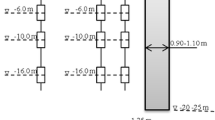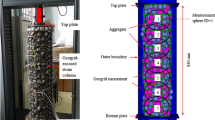Abstract
The scope of this paper is to emphasize the critical issues related to the axisymmetric and plane-strain modelling of single and group of stone columns constructed to stabilise soft soils. A simple technique based on the expansion of the column shaft was used to simulate the column installation so that the excess pore pressures during this process were calculated for a single column under axisymmetric conditions. Classical cavity expansion theory was also used for the same purpose. The group behaviour of stone columns was discussed by two-dimensional plane—strain numerical models. Plane-strain modelling of stone columns should consider the conversion of stiffness and the drainage properties of the columns and the soft soils to the plane-strain conditions. The validity of two different conversion methods based on the equivalent plane-strain stiffness and equivalent plane-strain permeability coupled with the expansion of the column shaft technique were investigated. An existing well-documented centrifuge test data were used as a reference for numerical models of axisymmetric single column and plane-strain column groups. The measured and calculated results were in good agreement for the case where the finite element model was constituted based on the equivalent plane-strain permeability. The results of this study intend to bring insight to the plane-strain modelling of a group of stone columns.
Similar content being viewed by others
References
Ammari K, Clarke BG (2018) Effect of vibro stone-column installation on the performance of reinforced soil. Journal of Geotechnical and Geoenvironmental Engineering 144(9), DOI: https://doi.org/10.1061/(ASCE)GT.1943-5606.0001914
Bailappanavar NI, Kumar M, Chatterjee K (2021) Effect of stone columns on strength and consolidation characteristics of black cotton soil. KSCE Journal of Civil Engineering 25(4):1214–1228, DOI: https://doi.org/10.1007/s12205-021-0863-6
Barron RA (1948) Consolidation of fine grained soils by drain wells. Transactions of the American Society of Civil Engineers 113(1): 718–754
Castro J (2014) Numerical modelling of stone columns beneath a rigid footing. Computers and Geotechnics 60:77–87, DOI: https://doi.org/10.1016/j.compgeo.2014.03.016
Castro J (2017) Modeling stone columns. Materials 10(7):782, DOI: https://doi.org/10.3390/ma10070782
Castro J, Sagaseta C (2009) Consolidation around stone columns. Influence of column deformation. International Journal for Numerical and Analytical Methods in Geomechanics 33(7):851–877, DOI: https://doi.org/10.1002/nag.745
Castro J, Sagaseta S (2011) Pore pressure during stone column installation. Ground Improvement 164(GI1), DOI: https://doi.org/10.1680/grim.9.00015
Debats JM, Guetif Z, Bouassida M (2003) Soft soil improvement due to vibrocompacted columns installation. Proceedings of the international workshop on geotechnics of soft-soils-theory and practice, September 17–19, Noordwijkerhout, Netherlands, 551–556
Duncan JM, Buchignani AL (1976) An engineering manual for settlement studies. University of California at Berkeley, Berkeley, CA, USA
Gäb M, Schweiger H, Kamrat-Pietraszewska D, Karstunen M (2008) Numerical analysis of a floating stone column foundation using different constitutive models. Proceedings of 2nd international workshop on soft soils — Focus on ground improvement
Gäb M, Schweiger HF, Thurner R, Adam D (2007) Field trial to investigate the performance of floating stone columns. Proceedings of the 14th European conference on soil mechanics and geotechnical engineering, Madrid, Spain
Gautray J (2014) Influence of smear and compaction zones on the performance of stone columns in lacustrine clay. PhD Thesis, ETH Zurich, Zürich, Switzerland
Ghorbani A, Hosseinpour I, Shormage M (2021) Deformation and stability analysis of embankment over stone column-strengthened soft ground. KSCE Journal of Civil Engineering 25(2):404–416, DOI: https://doi.org/10.1007/s12205-020-0349-y
Greenwood DA (1991) Load tests on stone columns. Proceedings of the ASTM specialty conference on deep foundation improvement: Design, construction and testing. ASTM Spec. Tech. Publ.
Guetif FZ, Bouassida M, Debats JM (2007) Improved soft clay characteristics due to stone column installation. Computers and Geotechnics 34(2):104–111, DOI: https://doi.org/10.1016/j.compgeo.2006.09.008
Hird CC, Pyrah IC, Russell D (1992) Finite element modelling of vertical drains beneath embankments on soft ground. Géotechnique 42(3):499–511, DOI: https://doi.org/10.1680/geot.1992.42.3.499
Indraratna B, Redana IW (1997) Plane-strain modelling of smear effects associated with vertical drains. Journal of Geotechnical and Geoenvironmental Engineering 123(5):474–478, DOI: https://doi.org/10.1061/(ASCE)1090-0241(1997)123:5(474)
Indraratna B, Redana IW (2000) Numerical modeling of vertical drains with smear and well resistance installed in soft clay. Canadian Geotechnical Journal 37(1):132–145, DOI: https://doi.org/10.1139/t99-115
Jaky J (1944) The coefficient of earth pressure at rest. Magyar Mérnök és Ëpitész Egylet Közdönye (Journal of the Society of Hungarian Architects and Engineers) 78:355–358
Jamiolkowski M, Lancellotta R (1981) Consolidation by vertical drains. Uncetainties involved in the prediction of settlement rates. X Interantional Conference on Soil Mechanics and Foundation Engineering, Stockholm, Sweden, 593–595
Kirsch F, Sondermann W (2001) Ground improvement and its numerical analysis. XV International Conference on Soil Mechanics and Geotechnical Engineering, Balkema, Istanbul, Turkey, 1775–1778
Lee FH, Juneja A, Tan TS (2004) Stress and pore pressure changes due to sand compaction pile installation in soft clay. Géotechnique 54(1): 1–16, DOI: https://doi.org/10.1680/geot.2004.54.1.01
McKelvey D, Sivakumar V, Bell A, Graham J (2004) Modelling vibrated stone columns in soft clay. Proceedings of the ICE-Geotechnical Engineering 157(3):137–149, DOI: https://doi.org/10.1680/geng.2004.157.3.137
Messerklinger S, Kahr G, Plötze M, Trausch Giudici JL, Springman SM, Lojander M (2003) Mineralogical and mechanical behaviour of soft Finnish and Swiss clays. Proceedings of the international workshop on geotechnics of soft soils — Theory and practice, September 17–19, Noordwijkerhout, The Netherlands
Messerklinger S, Springman SM (2010) Non-linear elasto-plastic behaviour of lacustrine clay. Geotechnical and Geological Engineering 28(2): 93–104, DOI: https://doi.org/10.1007/s10706-009-9280-1
Mestat P, Magnan JP, Ddhouib A (2006) Results of the settlement prediction exercise of an embankment founded on soil improved by stone columns. Numerical Methods in Geotechnical Engineering — NUMGE 06
Muir Wood D, Hu W, Nash DFT (2000) Group effects in stone column foundations: Model tests. Géotechnique 50(6):689–698, DOI: https://doi.org/10.1680/geot.2000.50.6.689
Munfakh GA (1984) Soil reinforcement by stone columns-varied case applications. International conference on in-situ soil and rock reinforcements, Paris, France, 157–162
Sharma JS, Xiao D (2000) Characterization of a smear zone around vertical drains by large-scale laboratory tests. Canadian Geotechnical Journal 37(6):1265–1271, DOI: https://doi.org/10.1139/t00-050
Springman SM, Laue J, Boyle R White J, Zweidler A (2001) The ETH Zurich geotechnical drum centrifuge. International Journal of Physical Modelling in Geotechnics 1(1):59–70, DOI: https://doi.org/10.1680/ijpmg.2001.010107
Springman SM, Laue J, Gautray J, Askarinejad A (2014) Ground improvement for embankments on soft ground. Ground Improvement 167(3):149–161, DOI: https://doi.org/10.1680/grim.13.00013
Stewart DP, Randolph MF (2001) T-bar penetration testing in soft clay. Journal of Geotechnical Engineering (ASCE) 120(12):2230–2235, DOI: https://doi.org/10.1061/(ASCE)0733-9410(1994)120:12(2230)
Tan S, Tjahyono S, Oo K (2008) Simplified plane-strain modeling of stone-column: Reinforced ground. Journal of Geotechnical and Geoenvironmental Engineering 134(2):185–194
Tang L, Zhang X, Ling X (2016) Numerical simulation of centrifuge experiments on liquefaction mitigation of silty soils using stone columns. KSCE Journal of Civil Engineering 20(3):631–638, DOI: https://doi.org/10.1007/s12205-015-0363-7
Vesic AS (1972) Expansion of cavities in infinite soil mass. Journal of Soil Mechanics and Foundations Division (ASCE) 98(3):265–290, DOI: https://doi.org/10.1061/JSFEAQ.0001740
Weber TM (2008) Modellierung der Baugrundverbesserung mit Schottersäulen. PhD Thesis, ETH Zurich, Zurich, Switzerland (in German)
Weber TM, Laue J, Springman SM (2005) Modelling the inflight construction of sand compaction piles in the centrifuge. Proceedings of the XVI international conference on soil mechanics and geotechnical engineering, 1291–1294
Weber TM, Plötze M, Laue J, Peschke G, Springman SM (2010) Smear zone identification and soil properties around stone columns constructed in-flight in centrifuge model tests. Géotechnique 60(3):197–206, DOI: https://doi.org/10.1680/geot.8.P.098
Wehr W (1999) Schottersäulen — das Verhalten von einzelnen Säulen und Säulengruppen. Geotechnik 22(1):40–47 (in German)
Acknowledgments
This study was funded by Scientific Research Projects Coordination Unit of Istanbul University-Cerrahpasa. Project numbers: 8371 and 8373. The first author is particularly grateful to Prof. Dr. Sarah M. Springman for the opportunity to work on this topic and be part of her group at ETH Zurich during his postdoctoral visit. In addition, the authors are grateful to Prof. Dr. Jan Laue and Dr. Thomas Weber, whose comments and suggestions have helped greatly improve the manuscript.
Author information
Authors and Affiliations
Corresponding author
Rights and permissions
About this article
Cite this article
Kelesoglu, M.K., Durmus, C. Numerical Plane-Strain Modelling of Stone Columns: Installation Process, Single and Group Column Behaviour. KSCE J Civ Eng 26, 3402–3415 (2022). https://doi.org/10.1007/s12205-022-1671-3
Received:
Revised:
Accepted:
Published:
Issue Date:
DOI: https://doi.org/10.1007/s12205-022-1671-3




